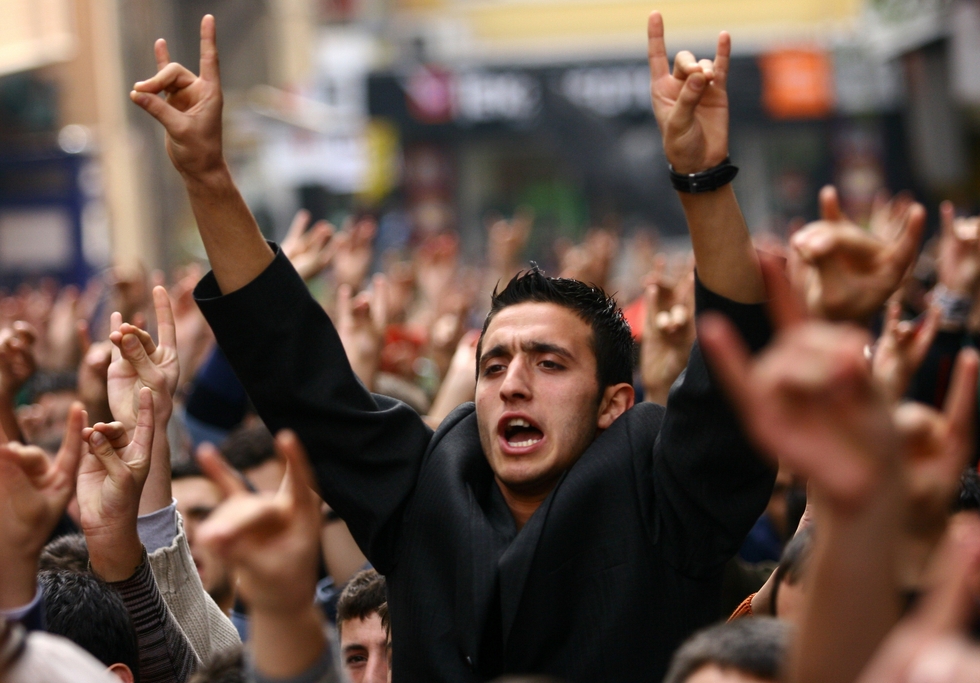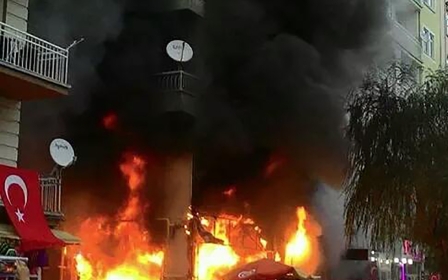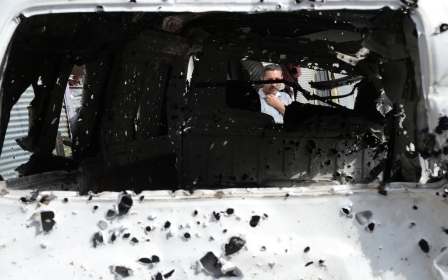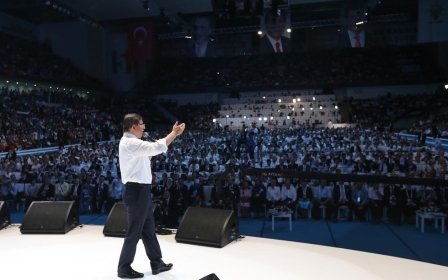Increasing tensions see resurgence of Turkey's far-right street movements

Throughout the several nights of anti-Kurdish riots that took place in mid-September, the five-fingered “wolf sign” was a ubiquitous sight among the protesters.
The gesture refers to the Grey Wolves, a far-right paramilitary organisation who have antagonised left-wing activists, Kurds and other minority groups in Turkey for decades.
However, the gesture has also become used as general symbol of Turkey’s nationalists, denoting the legend of Asena, a mythic she-wolf in Turkic (as opposed to Turkish) folklore.
For Turkey’s minorities, the gesture symbolises the chauvinism at the heart of the modern Turkish republic and its intolerance to pluralism.
The ideology of the Grey Wolves, and its political wing, the Nationalist Movement Party (MHP) is based on Pan-Turkism, though they have also been referred to by critics as neo-fascist. The MHP received the third-largest percentage of the vote share in June’s general election, showing for many that the Grey Wolves’ beliefs have been able to cross over into mainstream politics.
The founder of the MHP and Grey Wolves, Alparslan Turkes, advocated the unification of all the Turkic peoples, which in this sense referred to the Turkmen, China’s Uighurs, Russia’s Tatars, Azeris, Kazakhs and others.
Last month the Grey Wolves issued a warning that, while committed to staying within the law, the “Idealist Hearths” - an alternative name for the group - would mobilise their members should the security services fail to maintain order, in the wake of increasing conflict with supporters of the Kurdistan Workers Party (PKK).
“The Idealist Hearths are determined to continue their thoughts and acts through legal means, considering that the Turkish Republic is a state of law,” read the statement, written by the group’s head, Olcay Kılavuz.
“It is the main duty of the security forces to combat terrorism. We would only take on responsibility for this if the duty cannot be fulfilled.”
The statement also attacked President Recep Tayyip Erdogan, calling him the “worst disaster to ever hit Turkey”.
Since their founding in the late 60s, they have been staunchly committed to defending what they see as the integrity of the Turkish state - whether against revolutionary socialists, Christians, Kurdish separatists or Armenians calling for recognition of the 1915 genocide.
Among their slogans is “martyrs never die and the homeland will never be divided”.
“They are still a significant force, no matter which way you look at it,” said Ankarali Jan, a Turkish analyst. “The nationalist tradition has had a major impact on the formation of today's Turkey, and despite setbacks, they are still around.
“Most significant universities have Grey Wolf societies - more often than not unofficial - but their real power is on the streets, among disaffected poor people in predominantly Turkish Sunni neighbourhoods.”
Across continents, decades
The rap sheet of the Grey Wolves is long and eclectic, and stretches across several continents.
Their most notorious action was probably the Maras massacre in 1978, when Grey Wolves militants - falsely believing that leftists had attacked a cinema popular with nationalists - killed up to 150 people, mostly from the Alevi religious minority, in the southeastern town of Maras.
The massacre was a major factor in the 1980 military coup, which was highly popular with a large number of ultra-nationalists, who saw it as restoring stability and order following a period of major political upheaval.
In 1981, they made headlines again after one of their members attempted to assassinate Pope John Paul II.
Possibly their most dramatic act was in 1995, when they attempted to overthrow the government of Azerbaijan and reinstate the former President Abulfez Elchibey who held similar pan-Turkic views to the Grey Wolves, and had appointed the leader of the Azerbaijani Grey Wolves as minister of the interior.
Last month, Thailand was rocked by a bombing at a Hindu shrine in Bangkok, which killed 20 people. Two suspects were arrested, a Chinese man from Xinjiang - home to China’s Uighurs - and a Turkish national Adem Karadag.
Though neither suspect has been forthcoming (with one now having fled to Turkey), the arrest of a Turk and a Uighur - coupled with mounting anger at Thailand’s recent decision to deport 100 Uighurs to China where they face persecution - led some analysts to suggest that the attack had been carried out by a Grey Wolves supporter.
The reach of the Grey Wolves into the Turkish and pan-Turkic diaspora has been wide - according to a 2013 report in the German newspaper Neues Deutschland, the group is the largest far-right organisation in Germany.
"Most Grey Wolves outside Turkey live here [Germany], probably about 10,000," said Stephen G Humer, chair of the Terrorism Research Network in Berlin. "German Police often discovers weapons and solves cases of violence with a clear connection to Grey Wolves and their supporters."
On Sunday, an explosion occured at a Kurdish civil centre in Stockholm, Sweden, following clashes between Turks, Kurds and anti-fascists at a rally organised by the Swedish Grey Wolves.
The police suggested the two incidents could be linked, though they said it was still too early to confirm.
Last month, Brazilian supermodel Adriana Lima provoked controversy after being apparently duped into making the wolf sign - and howling - while in a gym in Turkey, leading to swift denials by her PR people that she had intended any political statement:
Tensions with Kurds
Kurdish activists have been the main focus of the Grey Wolves' ire since their inception.
As Turkey's largest ethnic minority, their calls for greater autonomy or changes to Turkey's constitution have been seen by the MHP and Grey Wolves as a threat against the integrity of the Turkish state.
During the several decades conflict between the PKK and the Turkish state which saw over 40,000 deaths, the Grey Wolves often acted as operatives of Turkish intelligence and were implicated in numerous killings of PKK leaders and other Kurdish activists.
Last week's wave of violence against offices of the pro-Kurdish People's Democracy Party (HDP) and Kurdish businesses, in response to an alleged PKK attack which killed 15 security officers the previous Sunday, followed a series of calls to action by the Grey Wolves to demonstrate against the increasing number of deadly attacks by Kurdish militants.
HDP offices in 56 provinces were attacked by nationalist activists, while in the capital Ankara the main headquarters of the HDP was ransacked by over 500 people. In the city of Kirsehir, more than 20 Kurdish-owned businesses and shops, including the city’s only bookstore, were burnt.
In Alanya, the HDP office was ransacked and a banner hung reading "you will see the power of the Turk" while a video released on YouTube showed ultra-nationalist activists chanting "we don't want operations, we want a massacre":
In the southeasrtern city of Mugla, a Kurdish man was beaten by a mob and forced to kiss a statue of Turkey's founder Mustafa Kemal Ataturk.
HDP co-leader Selahattin Demirtas went so far as to describe Kurds as facing a "campaign of lynching” as anger continued to mount among Turks at the repeated killings of security officials by supporters of the PKK and other left-wing and pro-Kurdish groups.
Ankarali Jan said the rioting was largely undirected and that it was impossible to assign clear blame to any one group, though use of ultra-nationalist symbolism, like the 'wolf sign', was commonplace.
"The protests were called by the Grey Wolves, but they also claim to have issued instructions that the protests finish promptly at 9.30pm - and hence they take no responsibility for what happened afterwards," he said.
"In some cities, the Ottoman Hearths (Osmanlı Ocakları), a still relatively small pro-Erdogan organisation modelled on the Grey Wolves, were more prominent at rallies than in others. I don't believe any organisation was directly 'responsible' for the mob violence that went on afterwards. They merely created conditions for it to happen - and for them not to have called for demonstrations after the deaths of over 30 security personnel over two days would have been a dereliction of much that they stand for."
Turkish security officials pose showing the 'wolf sign'.
A temporary calm
During the two-year ceasefire organised between the AKP government and the PKK, there was a reduction in public protest from ultra-nationalists. The leadership of the MHP was adamantly opposed to the peace process - with MHP leader Devlet Bahceli even promising to have Erdogan impeached for treason - but a support base weary of endless violence was more ambiguous.
New MEE newsletter: Jerusalem Dispatch
Sign up to get the latest insights and analysis on Israel-Palestine, alongside Turkey Unpacked and other MEE newsletters
Middle East Eye delivers independent and unrivalled coverage and analysis of the Middle East, North Africa and beyond. To learn more about republishing this content and the associated fees, please fill out this form. More about MEE can be found here.





